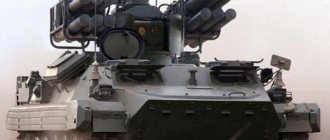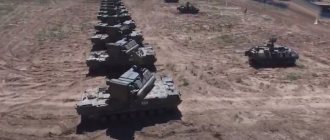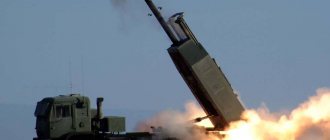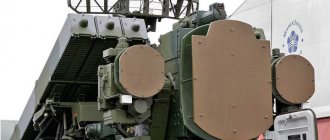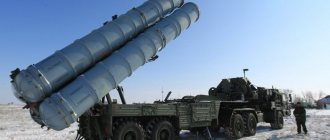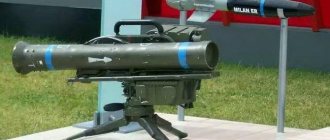Despite the difficult 90s, the general collapse of the armed forces and the military-industrial complex, Russian industry was able to maintain its potential and promising areas.
Domestic anti-aircraft missile systems are proof of this. We could list all types of missile defense and air defense missile systems for a long time, but suffice it to say that almost any name evokes respect and fear among all our potential opponents.
“Dvina”, “Pechora”, “Triumph”, “Cube”, “Dirk”, “Tor” - the list goes on. Many of these names are well known firsthand, probably to all foreign arms experts.
S-300 complexes of various modifications are well known in the Middle East. They took part in military conflicts more than once. And these and other domestically developed air defense systems have always caused understandable fear of the forces opposing them.
In April 2007, the S-400 Triumph long- and medium-range air defense system entered service. The complex is capable of destroying all modern air and space attack weapons. It can destroy not only modern means of attack, but also those that are just being developed and have not yet been adopted for service.
But the developer of all domestic modern air defense and missile defense systems does not stand still. The development of newer and more advanced weapons continues.
OJSC Air Defense Concern Almaz-Antey has developed a new ultra-modern next-generation anti-aircraft missile system, called the S-500 Prometheus (55R6M Triumfator-M).
This is already a complex of the future, no longer just an air defense system, but a system that will be included in the country’s aerospace defense.
The difference between the new complex and its predecessors is the use of separate solutions to problems in working with ballistic and aerodynamic targets. The multifunctionality of the complex will allow it to protect the facility from any type of aerospace attack. The S-500 anti-aircraft system is capable of hitting medium-range ballistic missiles (MRBMs), and, if necessary, can hit ICBMs (in the middle part of the trajectory). The complex is also capable of destroying all types of aircraft, UAVs, including promising hypersonic high-altitude missiles (5M and above). Another new feature of Prometheus is the destruction of low-orbit satellites, weapons from space and orbital platforms.
Such versatility allows the command to cover the desired object (it could be a region, a large city, an important strategic object, etc.) not with assorted means of defense, but with one single complex that solves all problems.
Already today, at the A.F. Military Space Academy. Mozhaisky crews are already being trained to service the S-500 complex. Operators, drivers and other specialists practice combat skills on ready-made simulators. Thus, by the time the complex is accepted into service and placed on combat duty, the crews will already be ready for service.
The structure of the S-500 division will be similar to the existing structure of the S-300 divisions, that is, from 12-17 vehicles.
Putting the S-500 systems on combat duty will be another heavy blow for the American military, which still cannot move away from our previous S-300 and S-400 systems.
Technical characteristics of the S-500 "Prometheus":
| Wheel formula | 10 x 10 |
| Engine | diesel 550 hp |
| Chassis curb weight | 21000 kg |
| Maximum load weight | 33000 kg |
| Maximum gross weight | 54000 kg |
| Maximum climbability | 30 deg. |
| Ford | 1.7 m |
Deputy General Director of the Almaz-Antey concern for foreign economic activity, Vyacheslav Dzirkaln, announced the imminent completion of tests of the S-500 anti-aircraft guided missile system, which is designed to intercept targets in the upper layers of the atmosphere.
He explained that individual elements of Prometheus “successfully passed the main part of the tests.”
“According to the plan, the transfer of the system is scheduled for 2022,” Dzirkaln said at the International Aviation and Space Salon (MAKS-2017), which is taking place these days in Zhukovsky near Moscow.
Shoigu revealed the appearance of the S-550 air defense system in Russia
Shoigu mentioned the name of this complex at a conference call, speaking about the president’s instructions, among other anti-aircraft missile systems put into service with the army.
Sergei Shoigu (Photo: Artem Geodakyan / TASS)
Russia has developed the S-550 anti-aircraft missile system, this became known from the speech of Defense Minister Sergei Shoigu at a conference call with the leadership of the armed forces.
“The Minister of Defense recalled that from November 1 to 3, the Supreme Commander-in-Chief held another series of meetings in Sochi with the leadership of the Ministry of Defense and enterprises of the military-industrial complex. Measures to adequately respond to changes in the situation near the Russian borders were considered. Much attention was paid to improving the country's aerospace defense system. The head of state placed special emphasis on the importance of the rapid development of domestic air defense systems and the supply of S-350, S-500, and S-550 systems to the armed forces,” the department said in a statement following the meeting.
Previously, the existence of an air defense or missile defense system in Russia under the symbol S-550 was not known. The only project with a similar name was developed at the end of the USSR, in the 1980s. It provided for the creation of a mobile missile defense system that could intercept, among other things, ballistic missiles. In 1988, work on the complex stopped. It is unknown whether this closed project is related to the new system mentioned by the Minister of Defense.
Military expert, director of the Center for Analysis of the Global Arms Trade, Igor Korotchenko, confirmed to RBC that the Russian Ministry of Defense had not previously reported on the S-550 complex.
“We know that the S-500 is a strategic missile defense system that is capable of hitting intercontinental-class ballistic missiles and destroying targets in near space. At the same time, the line of anti-aircraft missiles that are part of the S-500 ammunition allow you to destroy absolutely any target, from a drone to targets in space. There is no clearer explanation of what the S-550 is. Obviously, we must assume that this is some version, distinguished by an additional set of combat characteristics compared to the basic S-500... A system modernized for specific tasks or a range of targets that can be hit, which was created on the basis of the S-500,” the expert believes.
In near space
The S-500 is a long-range mobile anti-aircraft missile system (SAM), which is being developed to destroy any aerodynamic and ballistic targets. The main difference between Prometheus and other air defense systems is its interception range, which is 2-3 times greater than its American counterpart THAAD.
From open data it follows that the arsenal of long-range missiles of the S-500 consists of missiles of the 40N6M type (range of about 600 km) and hypersonic missiles 77N6-N and 77N6-N1, the tactical and technical characteristics of which are unknown.
Hypersonic missiles must overcome the speed limit of Mach 4-5 (Mach 1, or the speed of sound, is approximately 340 m/s). Experts suggest that 77N6-N and 77N6-N1 are capable of intercepting targets flying at speeds of up to 7 km/s (about Mach 20).
“We made a forecast for the development of aerospace attack weapons for the next 25 years. Our system must be able to deal with those goals that are not yet available today, but may appear. We are talking about interception in thin layers of the atmosphere, including in the upper layers of the atmosphere a hundred kilometers from the ground,” Pavel Sozin, general designer of Almaz-Antey, told the media.
Russian and foreign analysts agree that the S-500 is being created primarily to destroy objects in near space, that is, over 118 km from the Earth.
At such altitudes, Prometheus could have three targets: blocks of intercontinental ballistic missiles (ICBMs) in the final stage of flight, combat orbital platforms (which are presumably being developed by the United States) and satellites that are in orbits from 200 to 1000 km.
In addition, the S-500 is being developed to defeat all types of hypersonic lethal vehicles, including cruise and ballistic missiles. Three countries are actively working in this direction: Russia, the USA and China.
Ultimately, the Russian Ministry of Defense plans to obtain a universal air defense system that is capable of shooting down all air targets at any altitude: from ultra-low to ultra-long.
The targets of the S-500 should also be fifth-generation fighters. At the moment, the only country that has aircraft of this type in service is the United States. The Pentagon considers the F-22 and F-35 multirole fighters to be the fastest and most stealthy in the world.
Zhirinovsky's scarecrow: Instead of the S-700, Russia threatens the West with fakes
Russia allegedly has S-600 and S-700 anti-aircraft missile systems. This was announced on October 14 by the leader of the LDPR, State Duma deputy Vladimir Zhirinovsky . This is how the politician commented on the delivery of S-300 systems to Syria on the air of the “Evening with Vladimir Solovyov” program.
“And the Americans are afraid that the whole world will see that the best air defense system in the world is the Russian S-300. And we have S-400, S-500, S-600 and S-700. We can close the entire planet, and not a single plane will take off,” Zhirinovsky said.
The host of the show, Vladimir Solovyov, ironically asked the LDPR leader “not to disclose the S-1500 system,” to which the politician quite seriously replied that the S-700 “is the last one yet.”
Let us recall that for now, in reality, American military analysts are most concerned about the appearance of the promising S-500 complex, the development of which is being completed by the Almaz-Antey concern. Prometheus will be able to hit all types of targets flying at speeds up to Mach 20, and the system will have warheads of ballistic missiles and stealth aircraft within its range.
In May 2022, the American television channel CNBC, citing intelligence sources, reported that the S-500 successfully hit an aerial target at a distance of over 480 km, setting an absolute world record. Western analysts believe that Prometheus is capable of intercepting missiles, aircraft and satellites at a range of up to 500-600 km.
Read on topic
Because of our S-300s, Israel forced the United States to modernize the F-35. American aircraft may not be suitable at all for countering our systems
The first air defense system should enter service with the troops in 2022. The acquisition of the S-500 is included in the state armament program for 2018–2027. Prometheus will be armed with hypersonic missiles 77N6-N and 77N6-N1, as well as the 40N6 missile, the tactical and technical characteristics of which were published by Almaz-Antey in August at the Army-2018 forum.
40N6 is designed to intercept modern bombers, including those using stealth technology, fighters, strategic drones, high-precision missiles, including cruise and hypersonic ones. Also, the anti-aircraft guided missile is capable of destroying ballistic missiles flying at a speed of 4800 m/s.
“We made a forecast for the development of aerospace attack weapons for the next 25 years. Our system must be able to deal with those goals that are not yet available today, but may appear. We are talking about interception in thin layers of the atmosphere, including in the upper layers of the atmosphere, a hundred kilometers from the ground,” said Pavel Sozin, .
According to him, the S-500 is “not just a separate complex, but a system that solves a whole set of tasks of both air defense and missile defense.” Sozin is confident that Prometheus will surpass all existing and promising foreign analogues in its basic characteristics.
It’s stupid to think that the S-500 developers are sitting with their hands folded. But we can’t expect the S-600 and S-700 to appear as soon as possible.
What is behind Zhirinovsky’s words, what do the prospects for modernizing the S-500 look like in reality?
“Zhirinovsky is known for the fact that he can say anything, and nothing will happen to him for it,” notes former State Duma deputy (third and fourth convocations), retired colonel Viktor Alksnis . “And when he talks about the presence of the S-600 and S-700, his 1994 statements about the Elipton atomic pistol come to mind.” Then he assured that “the world has no idea about the real power of these weapons,” which allegedly killed 12 Bosnian soldiers in one of the tests.
It is not good to say in relation to a prominent politician that his statements are empty nonsense. Therefore, I will say differently: Zhirinovsky’s statement on air defense systems is from the realm of unsubstantiated statements. In fact, the possibility of further modernization of the S-500 rests on the problems of our economy.
30 years ago we were an industrial power, capable of producing 100% of the industrial products that were produced in the world at that time. Yes, perhaps the quality of domestic products was lower, and they were inferior to their imported counterparts in terms of technical characteristics. But the main thing is that we had this product.
However, since then the country has successfully undergone deindustrialization. And today we have lost thousands - without exaggeration - of industrial technologies. As a result, we are simply unable to produce many types of products, including defense ones.
"SP": - What exactly are these products?
“It is common knowledge that our fleet rearmament program has been disrupted. This happened primarily because we were unable to produce our own gas turbine and diesel marine engines. Previously, their supplies, let me remind you, were handled by a company located in the Ukrainian Nikolaev - a leading enterprise in this industry in Soviet times. Now the situation with the construction of our own engines seems to have improved, but to what extent is an open question.
We have seriously lost our position in aviation. It is no coincidence, in my opinion, that American experts do not consider the newest multirole fighter Su-57 a fifth-generation aircraft. It is symptomatic that this summer, Deputy Prime Minister Yuri Borisov said that there was no point in speeding up mass production of the Su-57. According to him, such a “visor” can always be played when aircraft of previous generations lag behind in their characteristics similar aircraft from the leading countries of the world.
As a result, about twenty Su-57s will be built. In fact, this is due to the fact that the fighter is expensive, and at the same time has significant problems with stealth and with the engine, which must ensure flight at supersonic speeds in cruising mode.
The situation is approximately the same with the newest Armata tank, which they threatened to supply to the Ground Forces in the amount of 2,500 units. Now the same Borisov says that the army does not seek to purchase Armata en masse because of its high cost, and that the modernization of old equipment requires less money, which allows saving budget money.
According to my information, the problem is not only in financing. We do not have the technologies that allow us to produce Armata in mass quantities. All we can really do is collect a dozen samples for parades on Red Square.
Finally, we are seriously inferior in the field of electronics. Until recently, according to experts, up to 80% of all electronic components on which our military equipment was assembled were imported. After the West cut off our oxygen by imposing sanctions, we lost the opportunity to receive military and space class microcircuits. And it turned out that the chips produced in Southeast Asia are not entirely suitable for military equipment. But we ourselves do not know how to make such microcircuits.
“SP”: — So, you don’t have to wait for the S-700 to appear?
— All of Zhirinovsky’s arguments about “closing the entire planet” are from the evil one. Unfortunately, we will not be able to make any S-600 and S-700 at the moment. It is too expensive for our economy, and too technically complex for our industry.
“Vladimir Zhirinovsky’s statement about the S-600 and S-700 complexes is not based on anything,” says military expert, retired colonel Viktor Litovkin . — Even the S-500 complex is still being created, and has not yet undergone any tests. And you need to understand: the only way the S-500 will differ from the S-400 is the presence of missiles that can operate on satellites and spacecraft outside the atmosphere. Moreover, the S-500 will be able to intercept missiles with a kinetic strike.
Let me remind you that earlier, due to the impossibility of accurately hitting an enemy warhead, and in the event of a massive strike, the task was set to stop enemy missiles with an oncoming atmospheric nuclear explosion. This problem is solved by the second version of the missile defense around Moscow, called A-135. It came into operation in 1995.
Secret weapon
The preliminary design of the S-500 began in 2004. Information about the first tests appeared in 2009. And at the end of June 2014, the media reported the first successful test of a long-range missile. What stage the creation of Prometheus is currently at has not been officially announced.
The deadline for completing the development of the S-500 and transferring it to the troops was constantly shifting due to the extremely difficult task that was assigned to Almaz-Antey: Prometheus must fire at up to 10 targets simultaneously, and the reaction time should not exceed four seconds.
It is assumed that the S-500 will nullify the striking power of a potential enemy. The primary mission of the air defense system is to strengthen the missile defense of the Moscow region, for which the A-235 static system is currently responsible. The S-500 will become a mobile component of the Moscow missile defense system.
The importance of the project is eloquently evidenced by the fact that to date there is not a single photograph of the S-500. Experts and journalists have only a tentative sketch at their disposal, which does not allow them to judge the real characteristics of the system.
In their conclusions, think tanks and experts are based on the information announced by officials and the scientific and production capabilities that Almaz-Antey has.
As military observer for Rossiyskaya Gazeta Sergei Ptichkin believes, the S-500 will combine the capabilities of operational-tactical air defense and strategic missile defense. In its final form, “Prometheus” will be a kind of cerebral.
- Anti-aircraft missile system S-400
- Russian Ministry of Defense
Expert Sebastien Roblin from The National Interest argues that the S-500 should be an upgraded version of the S-400 Triumph. The difference between the new air defense system will be its ability to detect subtle air targets and shoot down a wide range of cruise and ballistic missiles.
“The S-500 is intended to replace the S-300 missile in Russia’s layered air defense system and to complement the S-400 air defense system, which will perform more traditional missions of combating aviation and intercepting short- and medium-range ballistic missiles,” says Roblin.
History of the creation of the S-500 “Prometheus” air defense system (55Р6М “Triumfator-M”)
The Russian complex (SAM) S-500 “Prometheus”, also called 55R6M “Triumfator-M”, began to be developed by Russian scientists in 2002 as a new generation anti-aircraft missile system (fifth generation SAM). The key feature of this mobile air defense system was supposed to be the interception of ballistic missiles at high altitudes and distances, but the designers also provided for the possibility of hitting air targets.
The original name of the Russian S-500 "Prometheus" (55Р6М "Triumfator-M") air defense system was "Vlastelin", however, after the completion of the research phase, a different name was chosen.
In mid-2011, a preliminary prototype of the S-500 “Prometheus” air defense system (55Р6М “Triumfator-M”) was created, after which the designers began the actual process of creating a unique air and missile defense system.
It was initially assumed that the S-500 “Prometheus” would be put into service in 2016, however, later, this date was decided to be postponed to 2022, however, due to the requirements of Vladimir Putin, the complex began to be more actively tested, which made it possible to bring the date of adoption closer S-500 "Prometheus" air defense system to the troops.
The US found out why Russia is “silent” about the S-500
The Kremlin says practically nothing about the newest long- and medium-range anti-aircraft missile system S-500 Prometheus for commercial reasons - Russian authorities believe that this could lead to a huge export failure of the S-400, writes the American publication National Interest.
“Potential customers may lose interest in the S-400 if they think the system is on the verge of obsolescence. Russia's strategically vital clients, such as Turkey and India, may well be unhappy that they overcame serious US diplomatic barriers, but at the same time bought expensive S-400 systems that will be obsolete by the time they are delivered,” analysts point out.
As American experts point out, in the future Russia will want to distribute the S-500 in its Armed Forces before offering it to foreign buyers.
“Specific plans for the export of the S-500 remain distant, the export of the latest air defense systems is impossible at least until 2022,
even under the best of circumstances. Therefore, the Kremlin risks jeopardizing current deals with the S-400, but also doing so without an immediate replacement. The Kremlin shot itself in the foot by announcing the S-500 too early, and is now keeping silent until the S-400 reaches the end of its market cycle,” experts say.
It is known that Chinese military personnel have already completed the test program for the S-400 purchased from Russia. Chinese specialists conducted their second successful firing of the S-400 in December last year.
“One 48N6E missile fired by the system’s firing unit hit an aerodynamic target flying at a speed of more than 600 meters per second,” the military said.
The target was hit at maximum range, as during the first tests. The target was hit at a range of 250 kilometers, FAN
.
In November last year, the American television channel CNBC stated that the S-400 Triumph is cheaper than a number of analogues produced in the USA, while surpassing them in a number of characteristics, FAN reports.
According to the channel's sources, the cost of the S-400 is $500 million, while the Patriot complex costs about $1 billion, and the THAAD system costs about $3 billion. Moreover, in comparison with American systems, the S-400 can counter a wider range of targets, and also for several purposes simultaneously.
It was noted that
The lower cost of the Russian air defense system is due to the fact that technical support and maintenance are not supplied with it when sold.
In the same month, Turkish Foreign Minister Mevlüt Çavuşoğlu, at a meeting with US Secretary of State Mike Pompeo, confirmed the S-400 Triumph air defense system.
“This deal is a done deal. I cannot cancel it,” Cavusoglu emphasized, speaking about the purchase of the S-400. At the same time, Türkiye intends to buy weapons from its allies, the diplomat added.
Previously, Washington threatened its allies with sanctions if they decided to buy Russian S-400 air defense systems. This statement was made by US State Department spokesperson Heather Nauert in August. She emphasized that anti-aircraft missile systems created in the Russian Federation are incompatible with NATO systems and American THAAD air defense systems.
Nevertheless, the S-400 air defense system is popular on the global arms market. Some of the strongest armies in the world are showing interest in the complex - for example, at the beginning of October 2022, Russia and India entered into an agreement for the supply of S-400. Thus, India has become the third foreign buyer of air defense systems. According to Chief of Army Staff Bipin Rawat, New Delhi bought the Triumphs despite Washington's threats to impose sanctions.
A little earlier, LDPR leader Vladimir
Zhirinovsky said during a television broadcast that Russia already has new S-600 and S-700 air defense systems.
According to him, they can close down the entire planet so that not a single military aircraft of another country will take off. When the presenter asked the deputy not to give away all the secrets, for example, about the S-1500 complex, the parliamentarian said that after the S-700, other air defense systems will become unnecessary. Zhirinovsky assured that this complex will prevent the takeoff of all missiles in the world, NSN
.
“This is bullshit. Even the S-500 has not yet been put into service, Zhirinovsky does not yet have the information, it is simply unknown what it carries. Some kind of nonsense. You can designate anything as anything, even S-1000000. Now the S-500 is being created,” this is how Konstantin Sivkov, corresponding member of the Russian Academy of Missile and Artillery Sciences, captain of the first rank, commented on the words of the State Duma deputy.
"Five hundred" is on the way
The highlight of the S-500 will be the 40N6M missile, which in the West is called “Nudol”. As far as is known from the open press, this is the name of not just one missile, but the entire development project, within the framework of which the latest anti-missile and anti-satellite defense system was created.
It was originally intended to become an integral part of the S-500 Prometheus anti-aircraft missile system. By the way, high-ranking American military officials began to express their concerns immediately after they learned about the start of successful launch tests of missiles created on the “Nudol” theme. There is something to worry about. Nothing like this has ever been created in the world.
According to ancient mythology, the titan Prometheus protected people from the tyranny of the gods. Its name perfectly matches the purpose of the S-500 - a system that can reliably protect our country from external aggression.
There have not yet been similar anti-aircraft missile systems in our country, and they will not appear abroad in the foreseeable future.
Several types of missiles have been created for this system, including especially powerful ones - the same “Nudoli”. The S-500 is capable of destroying all air targets within a radius of up to 400 kilometers, and missiles, including hypersonic ones, at a range of 600 km.
It was reported that the S-500 will intercept intercontinental ballistic missiles at the final stage of the trajectory, and, within certain limits, in the middle segment of the flight. In addition, the rockets of this system can easily reach spacecraft located in low orbits. Namely, they operate a significant part of reconnaissance and telecommunications satellites.
In fact, the S-500 is becoming a mobile system not only for air defense, but also for missile defense. Some experts even consider Prometheus to be the first generation of anti-space defense systems. Not anti-missile, but anti-space, capable of destroying space objects located in their orbits. However, it is also very effective against missiles.
Perhaps some of the “five hundred” will be included in Moscow’s unified missile defense system. One S-500 complex will be able to process and fire at ten targets simultaneously with a high probability of hitting.
Testing of high-power missiles began in 2014 at the Plesetsk test site in the Arkhangelsk region. It was reported that successful launches were also carried out against space objects.
The S-500 destroys all air targets and missiles, including hypersonic ones, within a radius of 600 km
Testing of various S-500 subsystems proceeded intensively and successfully last year and the year before. It is possible that missile launches of interceptor missiles were also carried out from the territory of Kazakhstan. It is there that the Sary-Shagan test site is located, where in Soviet times long-range anti-aircraft missiles were tested, including those that were included in the missile defense system of the USSR and then Russia. After the collapse of the Union, the site was mothballed, but in 2022, under an interstate Russian-Kazakh agreement, work on it resumed.
It is worth recalling that the United States withdrew from the Treaty on the Limitation of Anti-Ballistic Missile Systems back in 2001; the Treaty ceased to apply in 2002. Therefore, at present, nothing limits us in the deployment of mobile missile defense systems. Moreover, the United States is already installing its anti-missile systems in Europe, including near the borders of our state.
In addition, the Pentagon is actively implementing the “Prompt Global Strike” concept. It also provides for the attack of hypersonic weapons on enemy territory from space. The appearance of the S-500 in this regard is very timely. Our defense system largely nullifies the strike capabilities of the most promising American missiles.
“Prometheas” are capable of reliably covering large cities, missile units of the Strategic Missile Forces, and the most important industrial areas, as well as hydroelectric and nuclear power plants.
It was previously reported that the S-500 will be put into service and begin to enter service with the troops this year. And at the beginning of this year, the newest S-350 Vityaz anti-aircraft missile system first entered combat duty in one of the units of the Aerospace Forces located in the Leningrad region.
In the next seven years, 12 divisions of such systems should be supplied to the Russian Armed Forces - a total of 144 complexes. The American magazine Newsweek, by the way, has already dubbed the “Vityazis” cruise missile killers.
Experts believe that the S-500 and S-350, working in tandem, will make it possible to cover important objects with an almost impenetrable layered umbrella.

